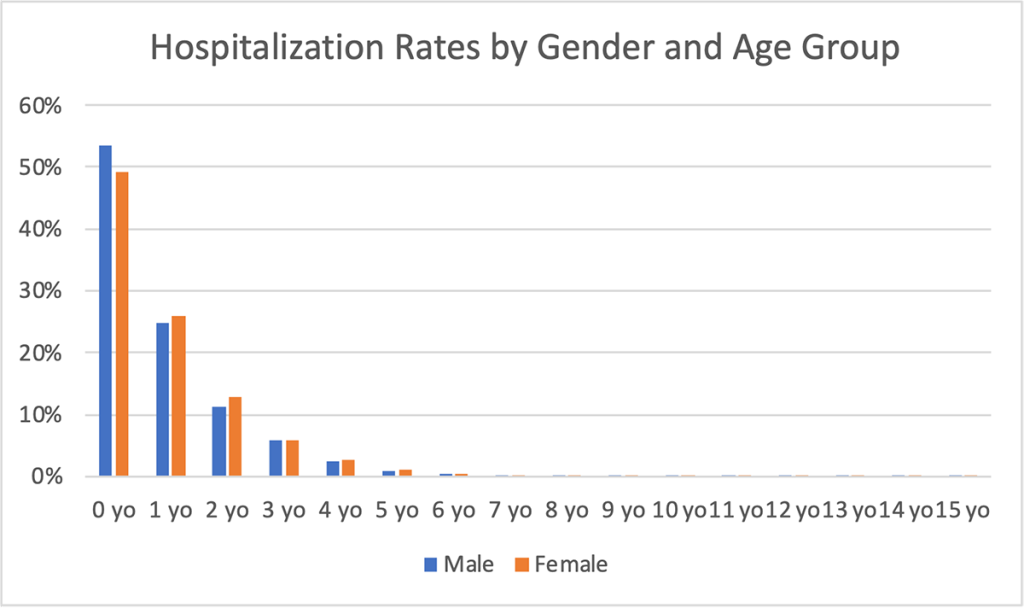
Analysis of Age-Specific Trends and Hospitalization Rates for Respiratory Syncytial Virus Infection
December 27 is recognized as International Day of Epidemic Preparedness. In 2020, approximately one year after the first confirmed cases of COVID-19, the United Nations designated this day to emphasize the importance of preparedness against infectious diseases.
In this context, we conducted an investigation into Respiratory Syncytial Virus (RSV) infection. RSV is a respiratory illness caused by the RSV virus, primarily affecting children. Its infection rate is exceptionally high, with over 50% of children infected at least once by their first birthday and nearly 100% by the age of two.
Using data from Medical Data Vision (MDV), we analyzed trends in the number of patients by age group, trends in the number of patients under the age of 15, and the proportion of hospitalizations by age and gender in individuals under 15 years old.
First of all, we would like to examine the data reporting the RS Virus infections by age segment.
Analysis of Age-Specific Trends in RSV Patients

Target Diseases: 0799008 RS Virus Infection, 8848687 RS Virus Encephalopathy, 8830136 RS Virus Pneumonia, 8830134 RS Virus Bronchitis, 8830135 RS Virus Bronchiolitis
Data Period: September 2019 – August 2024
Only all facilities which have continuous data within the target period
Number of Facilities Meeting the baseline condition: 174
The number of infections decreases significantly after the age of four, with few cases observed among adults. The data showed a particularly high number of cases among infants under one year of age.
Furthermore, we examined the trends in the number of patients by age group for those aged 15 and under.
Trends in Patients Under the Age of 15

Target Diseases: 0799008 RS Virus Infection, 8848687 RS Virus Encephalopathy, 8830136 RS Virus Pneumonia, 8830134 RS Virus Bronchitis, 8830135 RS Virus Bronchiolitis
Data Period: September 2019 – August 2024
Only all facilities which have continuous data within the target period
Number of Facilities Meeting the baseline condition: 174
Among infants under one year of age, the number of cases was approximately 22,000, the highest of all age groups. This number was found to halve by the time children reached one year of age. Beyond the age of six, the number of cases remained very low, as seen in the data.
Symptoms and Risk of Severe Disease
Symptoms of RSV infection range from mild cold-like symptoms, such as fever and nasal discharge, to severe pneumonia. The risk of severe disease is particularly high during the initial infection. Infections in infants under six months of age can lead to serious complications, such as bronchiolitis and pneumonia.
Hospitalization Rates by Age and Gender Among Patients Under 15

Target Diseases: 0799008 RS Virus Infection, 8848687 RS Virus Encephalopathy, 8830136 RS Virus Pneumonia, 8830134 RS Virus Bronchitis, 8830135 RS Virus Bronchiolitis
Data Period: September 2019 – August 2024
Only all facilities which have continuous data within the target period
Number of Facilities Meeting the baseline condition: 174
Hospitalization due to RSV infection was most common in infants under one year, accounting for approximately 50% of all cases. A slightly higher proportion of hospitalizations was observed in male infants. The rate of hospitalization decreased significantly after the age of two, with almost no hospitalizations recorded in children aged five years and older.
This analysis indicates that the risk of severe disease from RSV infection is particularly high in infants aged 0–1 year.
Note: This article was published on December 1, 2024.
Data survey and analysis tailored to your specific requests
Databases, data analysis requests, and more.
© Medical Data Vision Co., Ltd. All Rights Reserved.





